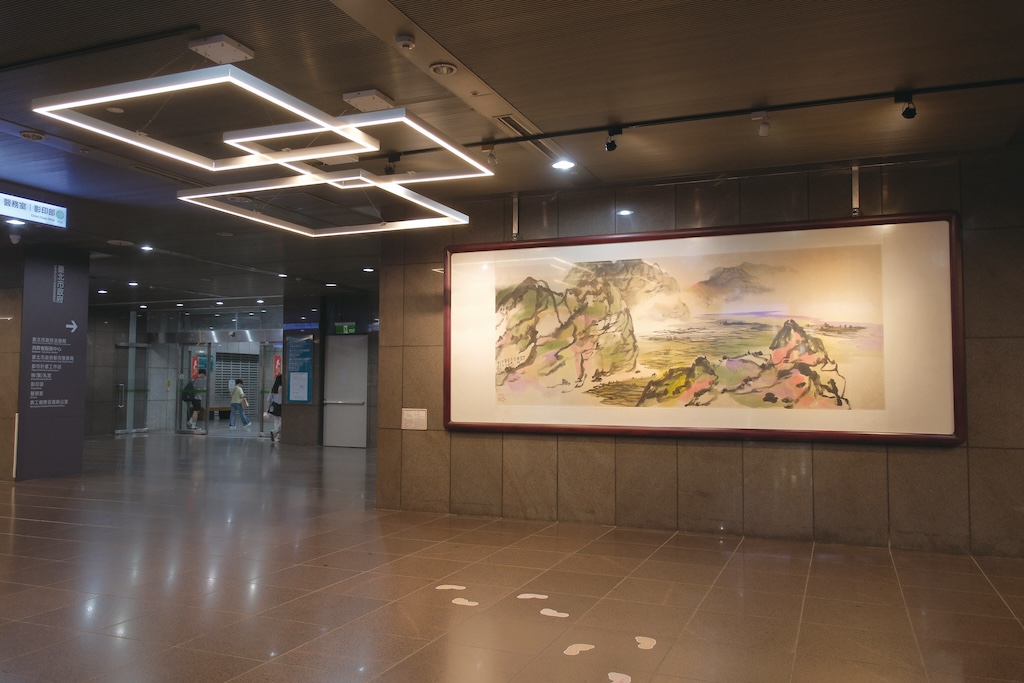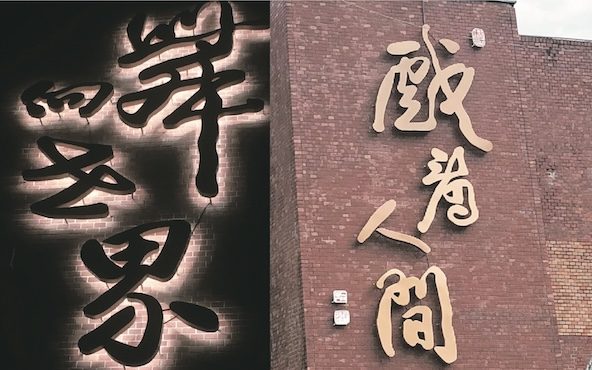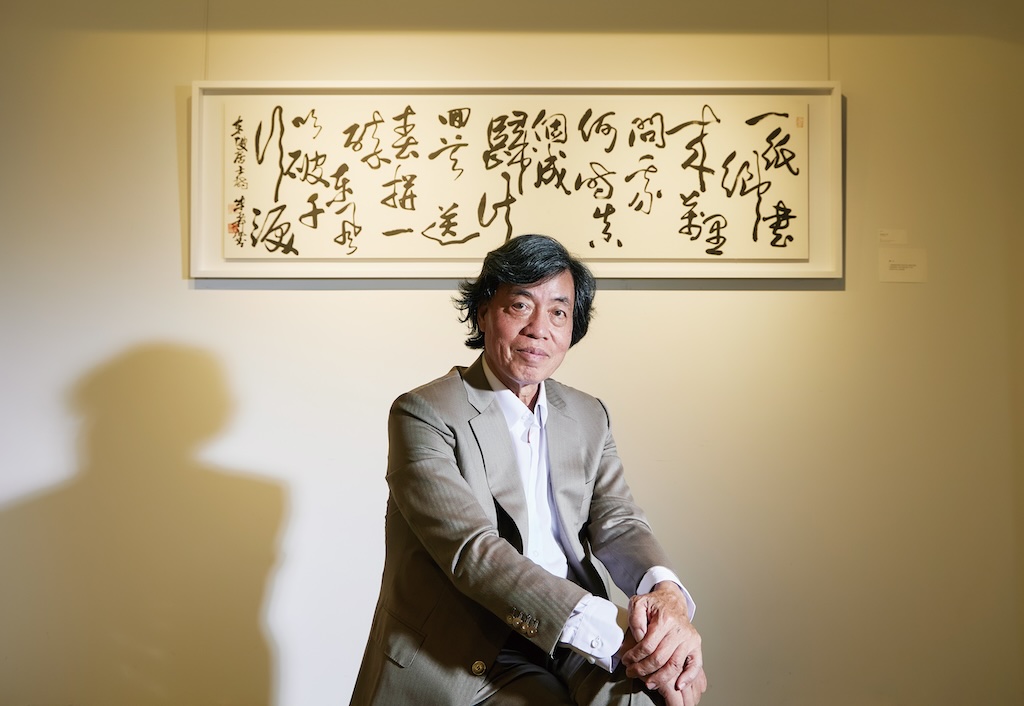Author Kai-Ping Fang
Photographer George Zhan, Nan Art
Chu Chen-Nan, a revered figure in calligraphy and ink wash painting, is well known for his inscriptions entitled Taipei Station and Taiwan Taoyuan International Airport. Additionally, On the way (在旅行的路上), located inside the first terminal of the airport, is the busy transport hub’s most photographed piece among travelers, though most are likely unaware this is also one of Chu’s works.

Chu seamlessly blends tradition with contemporary elements, enchanting audiences worldwide with his aesthetic. Within the city of Taipei, Chu’s calligraphy masterpieces grace the metropolitan landscape, contributing significantly to the modern development of this ancient art form.
Art, especially calligraphy, is often regarded as an esoteric realm accessible to a select few. However, Chu believes, “Art should be accessible to the masses.”
Unveiling the Evolution of Calligraphy Culture in Taipei
As a seasoned calligrapher and painter, Chu has dedicated himself for years to studying Taipei’s calligraphic heritage and its historical origins. His insights stem from a lifelong commitment to the art form.

Chu recalls how Japanese calligraphy significantly influenced northern Taiwan before 1949, with the celebrated Tsao Chiu-pu (曹秋圃) of the Danlu Calligraphy Society (澹廬書會) emerging as a prominent figure during that era. Subsequently, after the Nationalist government’s arrival in Taiwan, these new calligraphy luminaries led the Taipei calligraphy community for nearly three decades. During this period, calligraphy evolved from studying ancient steles to focusing on calligraphy models, and the atmosphere in Taipei leaned towards a conservative approach deeply rooted in traditional Chinese calligraphy.
As globalization took its course, Taipei became a melting pot of diverse cultures which profoundly influenced the trajectory of local calligraphy. Returning artists from various countries brought innovative Western concepts, encompassing multiculturalism, abstract expressionism, postmodernism, and anti-traditional movements. The intense fusion of these distinct artistic genres sparked a renaissance, nurturing cross-disciplinary art that highlighted Taipei’s distinct features. Over time, modern Taipei calligraphy evolved to embrace self-expression, infused with Western elements, resulting in the exciting array of creative styles that we witness today.
The Wellspring of Calligraphy Creation
In Chu’s art, nature and human interactions serve as inspirations. Skillfully weaving elements from his surroundings, he captures grand and subtle nuances, infusing his own personal experiences to create spectacular artworks.
Chu’s profound connection with nature has its roots in his humble beginnings. Growing up in poverty, he was shaped by the remarkable influence of his mother’s wisdom. Etched in his memory are her words, “Do everything early in life, except for dying (做人什麼都要趁早,死不能早),” which fueled his passion for painting and calligraphy.
Whether it’s a personal creation or a commissioned work, Chu requires a personal connection with his subject. For example, when tasked with the writing of the inscriptions for Taipei Main Station (台北車站) and several other railway stations in Hualien (花蓮), he visited each one personally, tailoring his creative direction accordingly.
He discerned the need for distinct styles to reflect each station’s unique atmosphere, exemplifying his unwavering commitment to his art. Through his travels, Chu has also produced numerous artworks in global settings such as the Cité des Sciences et de l’Industrie, Notre-Dame de Paris, and Fontbonne University in St. Louis. These encounters with architectural marvels and diverse cultures have influenced his artistry in more ways than one.
Taipei and Taiwan: Nurturing Calligraphy Aesthetics
Both Taipei and Taiwan as a whole shape Chu’s aesthetics. Taiwan’s cultural heritage and calligraphic tradition fuel his passion, while Taipei’s vibrant atmosphere adds an international dimension to his creations.

Chu has frequently painted Taipei, particularly during his realistic era as an artist. Armed with a keen sense of observation, he captured the essence of Taipei’s architecture, vegetation, and people. Through countless paintings he relentlessly explored the city’s distinctive style and characteristics, uncovering subjects in the ordinary streetscapes of the grand metropolis. Taipei City is not only his home but also his inspiration.

A City Filled with Calligraphy
As Chu points out, “Taipei is unquestionably a haven for calligraphy enthusiasts.” Public institutions like Sun Yat-sen Memorial Hall and Chiang Kai-shek Memorial Hall showcase the art form well. Even private establishments like Dalai Food (大來小館) and Din Tai Fung also display the works of esteemed calligraphers.

Chu’s works are also showcased at the Ever Rich Duty Free inside Taoyuan International Airport, Taipei City Hall, and the School of Music, Taipei National University of the Arts (國立台北藝術大學音樂學院). There are many more public spaces such as the evocative Yue Yang Lou Ji (岳陽樓記) in the International Hall of National Taipei University of Technology (台北科技大學國際廳).
Of course, the National Palace Museum is also a treasure trove of collected calligraphy, housing a rich collection of masterpieces from different eras, as is Taipei Artist Village (台北國際藝術村), hosting dynamic exhibitions for contemporary calligraphers.
Chu’s personal gallery, Nan Art (南院藝術), situated on Section 1, Xinsheng South Road (新生南路一段), offers an immersive experience into his ever-evolving artistry. In Nan Art, there are different themed exhibitions. You can see Chu’s work from every era, including his European-influenced work from when he studied in Paris. Various fonts and sizes in his calligraphy works can all be seen at this very place.
Appreciating Calligraphy as a Layperson
Chu believes that the ethos of calligraphy is rooted in its embodiment of truth, goodness, and beauty. His advice for appreciating these artworks, even for an audience without an extensive background in the art, centers on keenly observing the overall momentum and brush strokes. Elements such as elegance, theme, style, and seals contribute to the viewer’s perception, while presentation shapes the overall appreciation experience.
“When appreciating calligraphy, there’s no need for excessive expertise. One simply needs to feel with their heart, savor slowly, and even if they don’t fully understand, they can still find enjoyment in the beauty of appreciation,” Chu explains.

Chu values “trusting one’s instincts” in art appreciation. No excessive expertise needed; everyone can find delight in its beauty through their unique perspectives.












